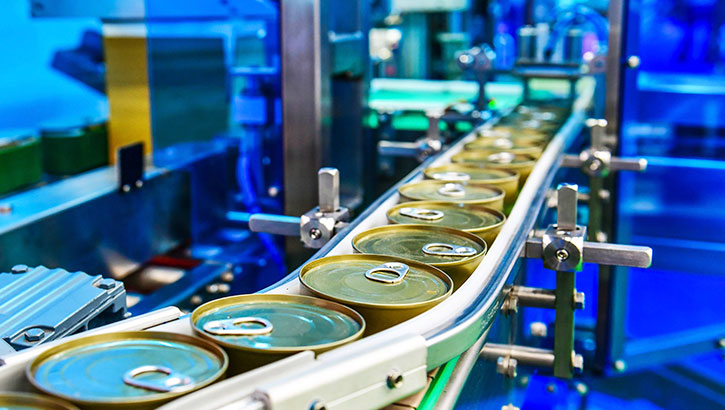The food industry is constantly evolving thanks to technological advances that improve efficiency, sustainability and safety in production processes.
Below, we explore some of the most recent innovations in machinery for this sector and their impact on the transformation of the industry:
1. Advanced automation and robotics
Automation has revolutionized the food industry with robotic systems performing repetitive tasks, from ingredient processing to packaging.
- Technology example:
- Collaborative robots (cobots): These robots work alongside humans on production lines, increasing efficiency and reducing the risk of workplace injuries.
- Automated production lines: Smart sensors automatically monitor and adjust parameters such as temperature, weight and quality.
- Benefits: Increase in production speed, reduction in operating costs and lower margin of error.
2. Artificial intelligence (AI) and machine learning
AI is used to optimize production processes, improve product quality and predict machine maintenance.
- Key applications:
- Quality inspection: AI cameras detect imperfections in food and products at unmatched speed and precision.
- Resource optimization: Algorithms predict demand, reduce waste and improve inventory management.
- Benefits: Greater consistency in product quality, less waste of raw materials and greater ability to adapt to market demands.
3. 3D food printing
3D printing has reached the food sector to create personalized products and innovative shapes, in addition to being used for prototype testing.
- Example of use: Production of chocolates, pastas, personalized decorations and even alternatives to meat from vegetable proteins.
- Benefits: Offers new design and customization possibilities, in addition to boosting creativity in food production.
4. Non-thermal preservation and processing technology
These technologies make it possible to maintain the quality, flavor and nutritional properties of food while guaranteeing its safety.
- Featured innovations:
- High Pressure Processing (HPP): Uses pressure instead of heat to inactivate pathogenic microorganisms, better preserving the original properties of the product.
- Ultrasonic dehydration: Allows you to reduce the water content in foods without affecting the texture or flavor.
- Benefits: Extends the shelf life of food, reduces the use of artificial preservatives and improves sustainability.
5. Internet of Things (IoT)
The connectivity of machines through IoT allows real-time monitoring and control of production processes.
- Example of use:
- Traceability systems: They allow ingredients to be traced from their origin to the final consumer, improving food safety.
- Predictive maintenance: Smart sensors detect potential failures before they occur, reducing downtime.
- Benefits: Increases transparency in the supply chain, reduces production interruptions and improves consumer confidence.
6. Sustainable machinery
Sustainability is a key factor in the design of new machinery, focusing on reducing the consumption of energy, water and other resources.
- Example of progress:
- Energy efficiency: Equipment that consumes less energy without sacrificing performance.
- Use of recyclable materials: Machinery manufactured with components that can be reused.
- Benefits: Reduction of the industry’s environmental footprint, compliance with environmental regulations and long-term savings.
7. Digitization and digital twins
Digital twins are virtual representations of production lines that allow processes to be simulated, monitored and optimized.
- Benefits:
- Simulation of processes before physically implementing them.
- Real-time data analysis to make quick and informed decisions.
- It allows you to test changes without interrupting production, reducing costs and implementation times.
8. Smart packaging
The development of packaging technologies not only protects food, but also improves the consumer experience.
- Key innovations:
- Active packaging: They interact with food to prolong its freshness, such as oxygen absorbers or humidity controllers.
- Smart labels: Sensors incorporated into packaging that indicate whether a product has been stored in optimal conditions.
- Benefits: Reduction of food waste and increased safety for the final consumer.
Innovations in machinery for the food industry are redefining the way food is produced, preserved and distributed. These technologies not only increase efficiency and reduce costs, but also respond to consumer demands for more sustainable, safe and personalized products. As these technologies continue to develop, it is expected that the food industry will continue to transform, adapting to a more connected and conscious world.
Starting from specific specifications in each case, we carry out the design and comprehensive production of Complete Lines that cover the specific needs of each client. Tell us about your needs and we will carry out a personalized project that adapts to your requirements. If you wish, we can work together from the beginning of the activity, renew your equipment or adapt to your new needs. Together, we are stronger. Each Project is unique and personal. Our capacity and experience enable us to tackle any possible project within the Food sector.
